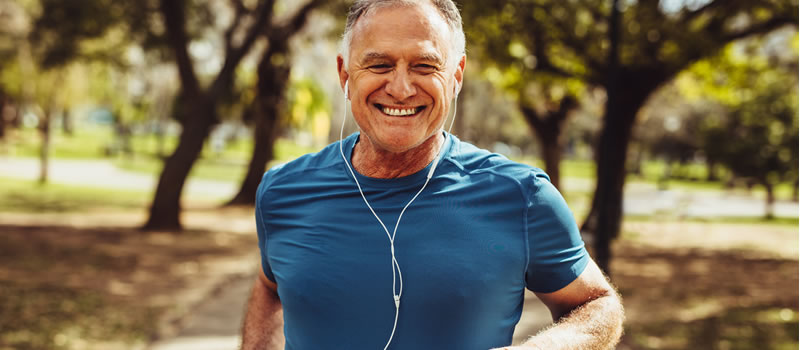Is working out good for your bones?
Published April 13, 2021

Questioning going to the gym today? Or not sure if you’ll find time for a run? If you need a bit of extra motivation, think of your bone health. Exercise is a great way to boost bone strength and prevent bone mass loss as you age.
How does exercise help your bones?
Like muscle, bone is living tissue that gets stronger when you exercise. Exercise not only helps you achieve greater peak bone mass (more on that later) when you are young, but it helps prevent bone loss as you age.
When stress is placed on the bones through exercises such as running, jumping, and weight lifting, bone cells called osteocytes send signals to other bone cells: osteoclasts, which remove damaged areas, and osteoblasts, which form new bone, eventually making the bones denser and stronger.
What is peak bone mass and why is it important?
Peak bone mass is the amount of bony tissue built up by the time your bones mature. The greater your peak bone mass the lower the risk of osteoporotic fracture in adulthood.
Bone formation and bone mineral accrual occur mainly in childhood and adolescence. Forty percent of bone mass is gained during adolescence, ninety percent by eighteen years and peak bone mass is reached by your late twenties. Getting your kids to play their favourite sport like basketball, tennis or football are all great ways to increase bone mass in childhood.
The best bone-building exercises for adults
Weight-bearing and resistance exercises are great exercises for your bones. Some studies have also shown low-intensity vibration therapy to be beneficial.
Low-intensity vibration therapy
Low-intensity vibration therapy uses a device to stimulate muscle and bone when you stand on it. Both the size and speed of the vibration, about thirty cycles per second, are set to match the natural stimulation that occurs when muscles relax and contract to maintain posture.
Weight-bearing exercises
Weight-bearing exercises force you to work against gravity. These include skipping, hiking, jogging, climbing stairs, playing tennis, and dancing.
Resistance exercises
Resistance exercises are any exercise that causes the muscles to contract against an external resistance. These include lifting free weights or using weight machines, working with resistance bands or using your body weight during exercises such as squats, push-ups and chin-ups.
Whichever exercise you choose, it will be vital for bone health throughout your life. For older adults, physical activity is the only single therapy that can simultaneously improve muscle mass, muscle strength, balance, and bone strength.
Combining exercise with a healthy lifestyle for bone health
Enhance all of your hard work at the gym by adding these bone-building lifestyle tips to your everyday.
- Reduce caffeine, salt and soft drink — Improve bone health by reducing caffeine, salt and soft drink. These can impact bone health and lead to calcium loss through the kidneys.
- Quit smoking and reduce alcohol — Quit smoking and only drink moderately to keep your bones strong.
- Eat you a nutrient-rich diet — Support bone health with a diet rich in:
-
- Calcium — Firm tofu, canned fish, yoghurt and dairy, leafy green vegetables, nuts and seeds.
- Magnesium — Leafy green vegetables, legumes, nuts, seeds and whole grains, spinach and potatoes.
- Vitamin D — Salmon, herring, mackerel, and eggs. Margarine, plant milks fortified with vitamin D. Healthy exposure to sunlight.
Working out regularly throughout your life will help build strong bones and prevent bone loss into adulthood. Combining your favourite weight-bearing and resistance exercises with a balanced diet will help keep your bones healthy, improve your balance and coordination and help prevent falls and potential fractures later in life.
MAT-AU-2002456
Learn about which Nature's Own product may be appropriate for you.
SEE THE PRODUCTS HERE







